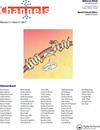TRPML1 as lysosomal fusion guard
IF 3.2
3区 生物学
Q2 BIOCHEMISTRY & MOLECULAR BIOLOGY
引用次数: 5
Abstract
TRP channels show remarkable diversity and influence many physiological functions. Most TRP channels are Ca2C permeable, reside in the plasma membrane and mediate Ca2C influx in response to various stimuli. However, members of the TRPML (mucolipins) subfamily reside in organelles and function as organellar channels. The subfamily includes three members and was established with the identification of TRPML1 as the protein mutated in the lysosomal storage disease (LSD) Mucolipidosis type IV (MLIV). All TRPML channels function as inward rectifying, Ca2C permeable cation channels and are activated by the organellar lipid PI(3,5)P2. TRPML1 is largely a lysosomal channel and is cleaved by lysosomal cathepsins, probably as an inactivation mechanism. TRPML3 is expressed mostly in early and late endosomes, while TRPML2 is found mainly in recycling endosomes. All TRPML channels function in organellar trafficking; nevertheless based on the knockout mouse phenotype, it appears that the roles of TRPML2 and TRPML3 are modest compared to TRPML1. TRPML3, a pH and NaC sensitive channel, has a role in autophagy, although knockout of TRPML3 has no obvious phenotype. The cellular role of TRPML2 is not well understood, but deletion results in a compromised immune response. Inactivating mutations of TRPML1 in humans and deletion of TRPML1 in mice result in LSD, indicating critical role of TRPML1 in lysosomal functions. Early studies demonstrated a role for TRPML1 in trafficking of early and late endosomes to and from the lysosomes, and in fusion of lysosomes with autophagosomes. Subsequent studies established TRPML1 as a lysosomal Ca2C release channel with a role in several lysosomal functions, including large particle phagocytosis, membrane repair and lysosomal trafficking to organelles and molecules designated for degradation. All the forms of lysosomal trafficking discussed above involve the constitutive trafficking pathway. Another important form of membrane trafficking is that associated with regulated exocytosis, such as secretion by acinar cells within exocrine glands, secretion by endocrine cells, and neurotransmitter release. Surprisingly, the role of the TRPML1 and the effect of any LSDs in regulated exocytosis have not been addressed before, although neurodegeneration is a common feature in all LSDs. In a recent study, we examined the role of TRPML1 in several forms of regulated exocytosis: Ca2C-dependent pancreatic exocytosis, cAMP-dependent salivary gland exocytosis, and neuronal exocytosis of glutamate. These studies showed that a major function of TRPML1 is to guard against uncontrolled fusion of the lysosomes with other intracellular organelles. The lysosome enlargement and increased lysosomal undigested content observed in LSDs indicate that the lysosomes do not lose their fusogenic potential in these diseases. This was revealed to be of major consequence in secretory cells containing fusogenicTRPML1作为溶酶体融合保护因子
TRP通道具有显著的多样性,并影响许多生理功能。大多数TRP通道是Ca2C可渗透的,存在于质膜中,并在各种刺激下介导Ca2C内流。然而,TRPML(粘磷脂)亚家族的成员存在于细胞器中,并作为细胞器通道发挥作用。该亚家族包括三个成员,通过鉴定TRPML1是溶酶体贮积病(LSD) IV型粘脂质沉积症(MLIV)中突变的蛋白而建立。所有TRPML通道都具有向内整流、Ca2C渗透性阳离子通道的功能,并被细胞器脂质PI(3,5)P2激活。TRPML1在很大程度上是一个溶酶体通道,被溶酶体组织蛋白酶切割,可能是一种失活机制。TRPML3主要表达于早期和晚期核内体,而TRPML2主要表达于再循环核内体。所有TRPML通道在细胞器运输中起作用;然而,基于敲除小鼠表型,与TRPML1相比,TRPML2和TRPML3的作用似乎不大。TRPML3是一种pH和NaC敏感通道,虽然敲除TRPML3没有明显的表型,但它在自噬中起作用。TRPML2的细胞作用尚不清楚,但缺失会导致免疫反应受损。人类TRPML1失活突变和小鼠TRPML1缺失导致LSD,表明TRPML1在溶酶体功能中起关键作用。早期研究表明,TRPML1在早期和晚期核内体进出溶酶体的运输以及溶酶体与自噬体的融合中发挥作用。随后的研究证实TRPML1是溶酶体Ca2C释放通道,在溶酶体的多种功能中发挥作用,包括大颗粒吞噬、膜修复和溶酶体转运到指定降解的细胞器和分子。上述讨论的所有形式的溶酶体运输都涉及构成运输途径。另一种重要的膜运输形式与受调节的胞外分泌有关,如外分泌腺内的腺泡细胞分泌、内分泌细胞分泌和神经递质释放。令人惊讶的是,尽管神经变性是所有lsd的共同特征,但TRPML1的作用和任何lsd在调节胞外分泌中的作用之前都没有得到解决。在最近的一项研究中,我们研究了TRPML1在几种形式的调节胞吐中的作用:ca2c依赖性胰腺胞吐、camp依赖性唾液腺胞吐和谷氨酸的神经元胞吐。这些研究表明,TRPML1的一个主要功能是防止溶酶体与其他胞内细胞器的不受控制的融合。在lsd中观察到的溶酶体增大和溶酶体未消化含量增加表明溶酶体在这些疾病中并没有失去其融合潜能。结果显示,这对含有融合原性的分泌细胞有重要影响
本文章由计算机程序翻译,如有差异,请以英文原文为准。
求助全文
约1分钟内获得全文
求助全文
来源期刊

Channels
生物-生化与分子生物学
CiteScore
5.90
自引率
0.00%
发文量
21
审稿时长
6-12 weeks
期刊介绍:
Channels is an open access journal for all aspects of ion channel research. The journal publishes high quality papers that shed new light on ion channel and ion transporter/exchanger function, structure, biophysics, pharmacology, and regulation in health and disease.
Channels welcomes interdisciplinary approaches that address ion channel physiology in areas such as neuroscience, cardiovascular sciences, cancer research, endocrinology, and gastroenterology. Our aim is to foster communication among the ion channel and transporter communities and facilitate the advancement of the field.
 求助内容:
求助内容: 应助结果提醒方式:
应助结果提醒方式:


